APIC PRV12007: Project Development and Optimisation Article Summary
VerifiedAdded on 2022/09/12
|8
|1503
|12
Report
AI Summary
This report provides a comprehensive summary of an article focusing on project development and optimisation, particularly within the context of Building Information Modelling (BIM) and Integrated Project Delivery (IPD). The article highlights the significance of integrating BIM with IPD to enhance project efficiency and reduce costs, emphasizing the use of 4D BIM automation and Activity Based Costing (ABC). Key findings include the application of genetic algorithms for multi-objective optimisation, resulting in substantial cost savings and improved project management. The summary also explores the benefits of IPD, such as improved decision-making and streamlined construction timelines, as well as the limitations of current research and potential areas for future investigation, including the integration of 4D and 5D BIM models for enhanced project planning and cost management. The report references several studies that support the use of BIM in construction projects. The article suggests a library for the AEC industry and the importance of collaborative cost management systems. The report concludes by emphasizing the automated optimization of construction methods and the importance of future research.
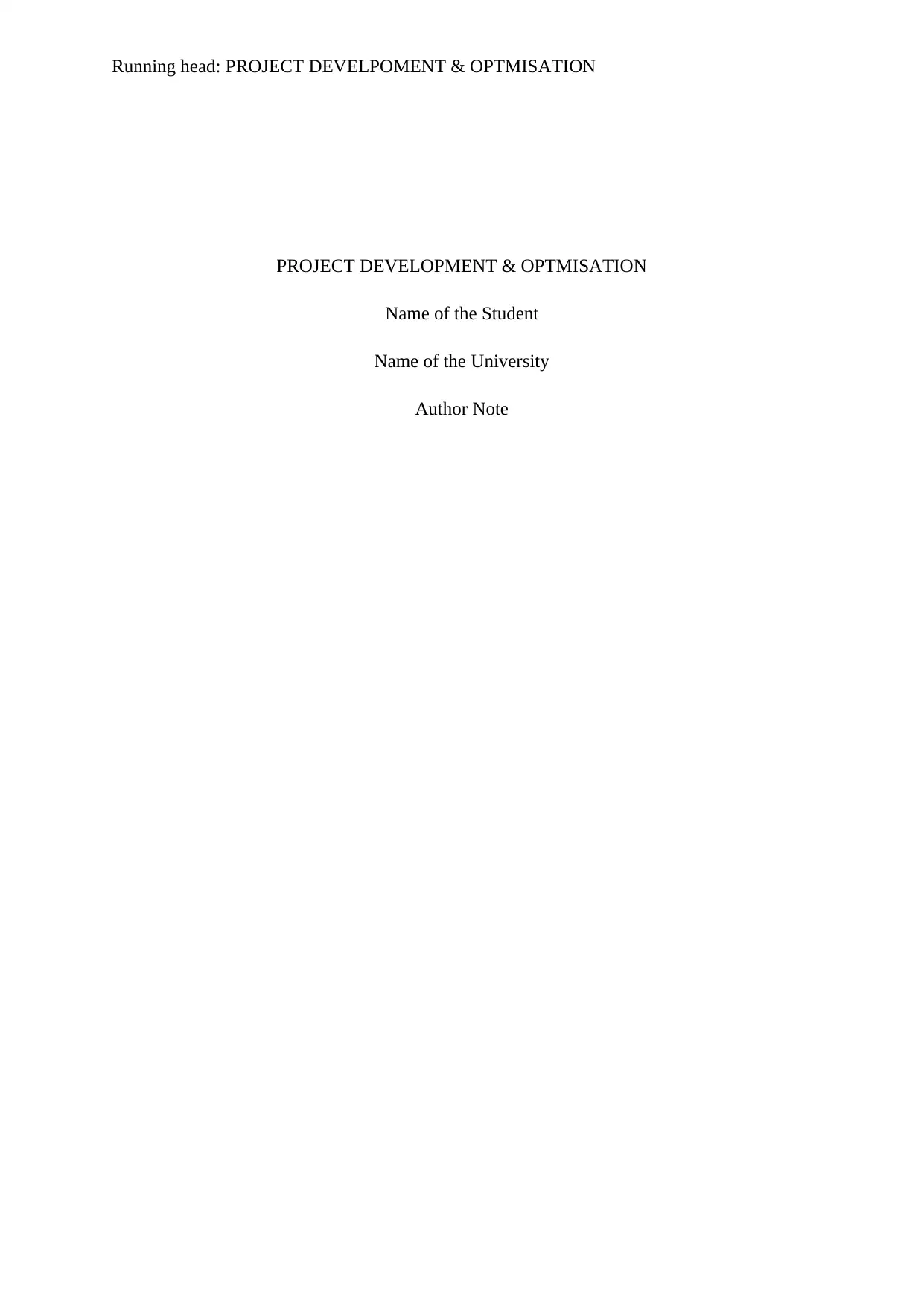
Running head: PROJECT DEVELPOMENT & OPTMISATION
PROJECT DEVELOPMENT & OPTMISATION
Name of the Student
Name of the University
Author Note
PROJECT DEVELOPMENT & OPTMISATION
Name of the Student
Name of the University
Author Note
Paraphrase This Document
Need a fresh take? Get an instant paraphrase of this document with our AI Paraphraser

1PROJECT DEVELOPMENT & OPTIMISATION
Table of Contents
Introduction................................................................................................................................2
Article summary.........................................................................................................................2
Conclusion..................................................................................................................................4
References..................................................................................................................................6
Table of Contents
Introduction................................................................................................................................2
Article summary.........................................................................................................................2
Conclusion..................................................................................................................................4
References..................................................................................................................................6
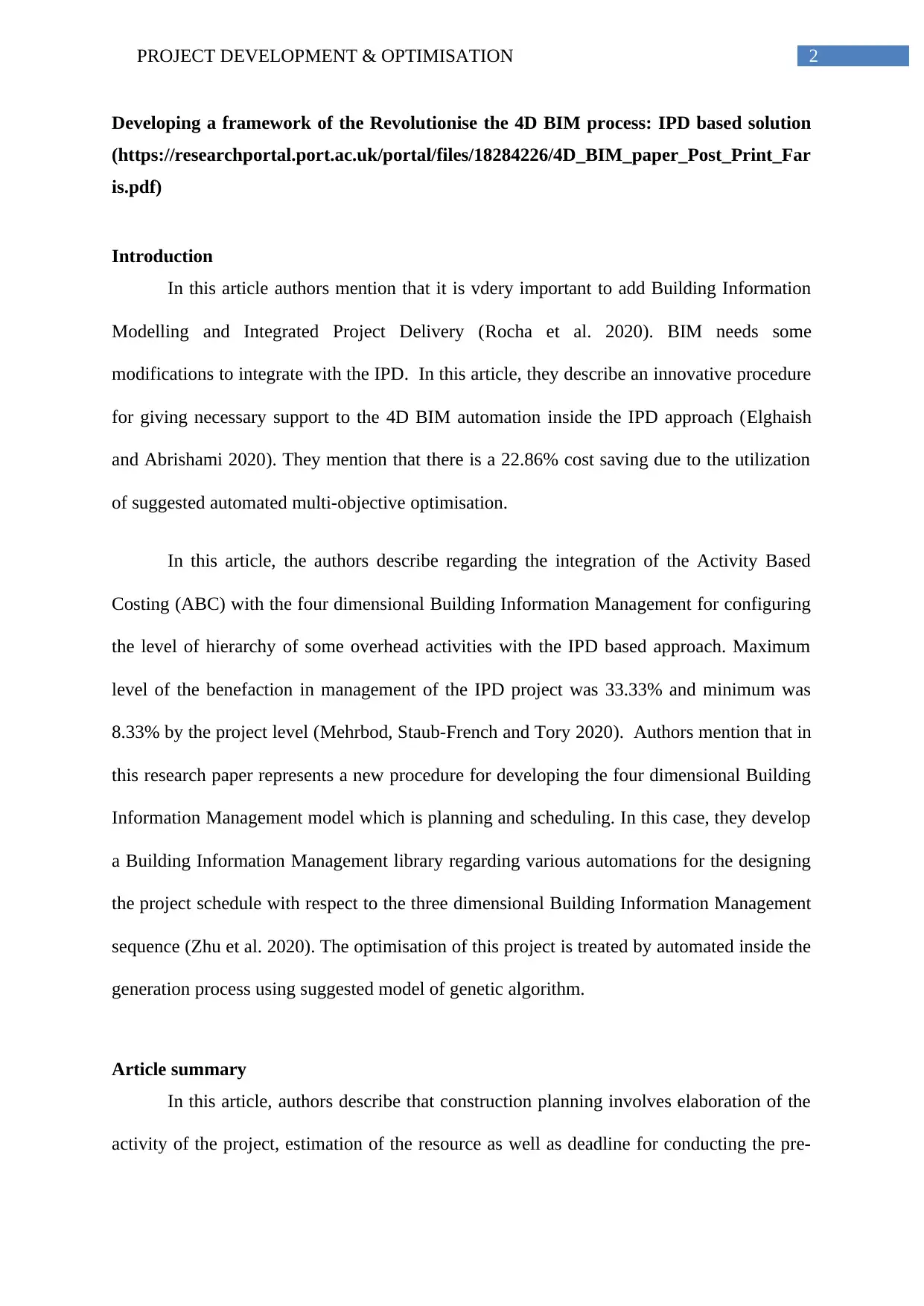
2PROJECT DEVELOPMENT & OPTIMISATION
Developing a framework of the Revolutionise the 4D BIM process: IPD based solution
(https://researchportal.port.ac.uk/portal/files/18284226/4D_BIM_paper_Post_Print_Far
is.pdf)
Introduction
In this article authors mention that it is vdery important to add Building Information
Modelling and Integrated Project Delivery (Rocha et al. 2020). BIM needs some
modifications to integrate with the IPD. In this article, they describe an innovative procedure
for giving necessary support to the 4D BIM automation inside the IPD approach (Elghaish
and Abrishami 2020). They mention that there is a 22.86% cost saving due to the utilization
of suggested automated multi-objective optimisation.
In this article, the authors describe regarding the integration of the Activity Based
Costing (ABC) with the four dimensional Building Information Management for configuring
the level of hierarchy of some overhead activities with the IPD based approach. Maximum
level of the benefaction in management of the IPD project was 33.33% and minimum was
8.33% by the project level (Mehrbod, Staub-French and Tory 2020). Authors mention that in
this research paper represents a new procedure for developing the four dimensional Building
Information Management model which is planning and scheduling. In this case, they develop
a Building Information Management library regarding various automations for the designing
the project schedule with respect to the three dimensional Building Information Management
sequence (Zhu et al. 2020). The optimisation of this project is treated by automated inside the
generation process using suggested model of genetic algorithm.
Article summary
In this article, authors describe that construction planning involves elaboration of the
activity of the project, estimation of the resource as well as deadline for conducting the pre-
Developing a framework of the Revolutionise the 4D BIM process: IPD based solution
(https://researchportal.port.ac.uk/portal/files/18284226/4D_BIM_paper_Post_Print_Far
is.pdf)
Introduction
In this article authors mention that it is vdery important to add Building Information
Modelling and Integrated Project Delivery (Rocha et al. 2020). BIM needs some
modifications to integrate with the IPD. In this article, they describe an innovative procedure
for giving necessary support to the 4D BIM automation inside the IPD approach (Elghaish
and Abrishami 2020). They mention that there is a 22.86% cost saving due to the utilization
of suggested automated multi-objective optimisation.
In this article, the authors describe regarding the integration of the Activity Based
Costing (ABC) with the four dimensional Building Information Management for configuring
the level of hierarchy of some overhead activities with the IPD based approach. Maximum
level of the benefaction in management of the IPD project was 33.33% and minimum was
8.33% by the project level (Mehrbod, Staub-French and Tory 2020). Authors mention that in
this research paper represents a new procedure for developing the four dimensional Building
Information Management model which is planning and scheduling. In this case, they develop
a Building Information Management library regarding various automations for the designing
the project schedule with respect to the three dimensional Building Information Management
sequence (Zhu et al. 2020). The optimisation of this project is treated by automated inside the
generation process using suggested model of genetic algorithm.
Article summary
In this article, authors describe that construction planning involves elaboration of the
activity of the project, estimation of the resource as well as deadline for conducting the pre-
⊘ This is a preview!⊘
Do you want full access?
Subscribe today to unlock all pages.

Trusted by 1+ million students worldwide
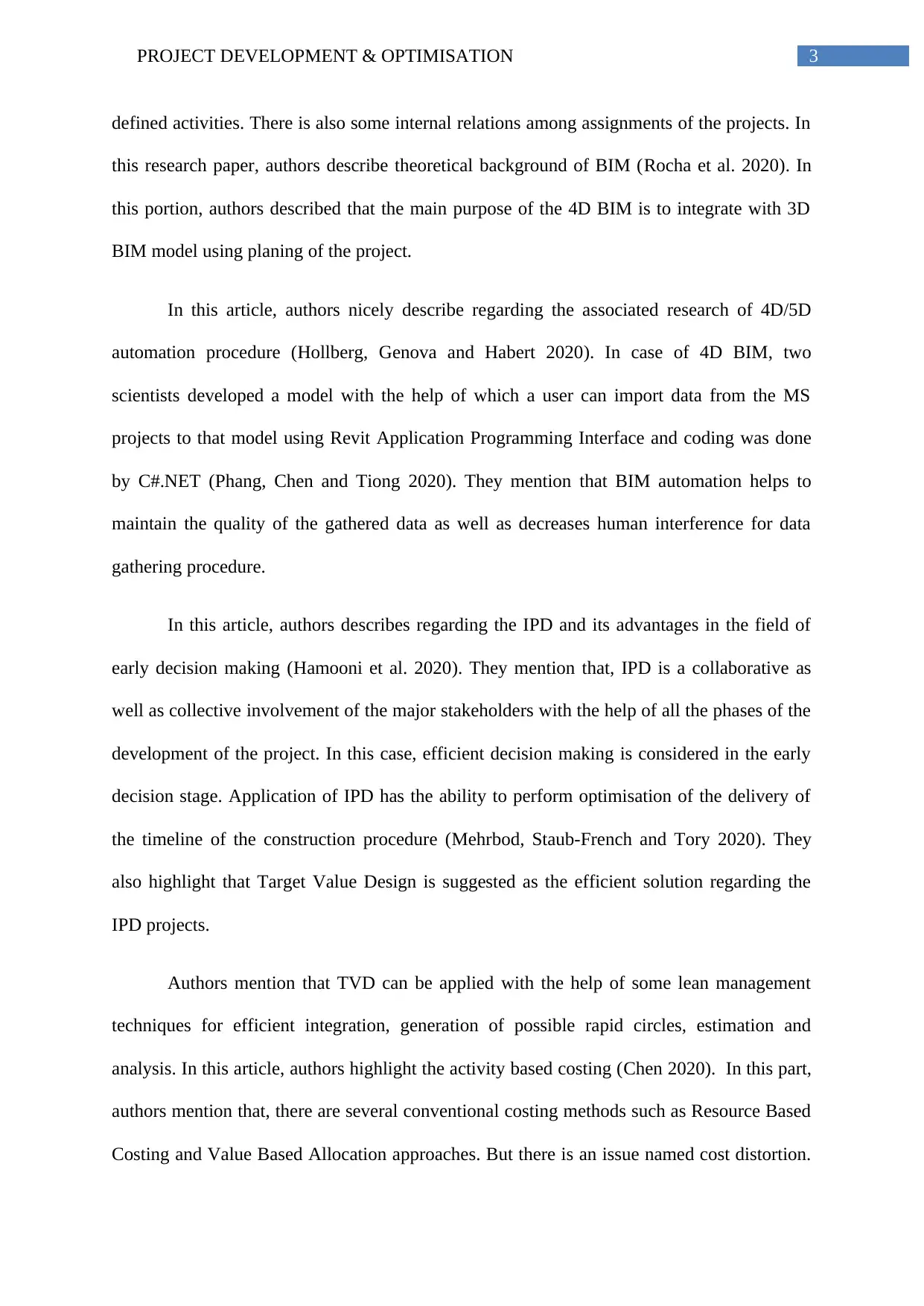
3PROJECT DEVELOPMENT & OPTIMISATION
defined activities. There is also some internal relations among assignments of the projects. In
this research paper, authors describe theoretical background of BIM (Rocha et al. 2020). In
this portion, authors described that the main purpose of the 4D BIM is to integrate with 3D
BIM model using planing of the project.
In this article, authors nicely describe regarding the associated research of 4D/5D
automation procedure (Hollberg, Genova and Habert 2020). In case of 4D BIM, two
scientists developed a model with the help of which a user can import data from the MS
projects to that model using Revit Application Programming Interface and coding was done
by C#.NET (Phang, Chen and Tiong 2020). They mention that BIM automation helps to
maintain the quality of the gathered data as well as decreases human interference for data
gathering procedure.
In this article, authors describes regarding the IPD and its advantages in the field of
early decision making (Hamooni et al. 2020). They mention that, IPD is a collaborative as
well as collective involvement of the major stakeholders with the help of all the phases of the
development of the project. In this case, efficient decision making is considered in the early
decision stage. Application of IPD has the ability to perform optimisation of the delivery of
the timeline of the construction procedure (Mehrbod, Staub-French and Tory 2020). They
also highlight that Target Value Design is suggested as the efficient solution regarding the
IPD projects.
Authors mention that TVD can be applied with the help of some lean management
techniques for efficient integration, generation of possible rapid circles, estimation and
analysis. In this article, authors highlight the activity based costing (Chen 2020). In this part,
authors mention that, there are several conventional costing methods such as Resource Based
Costing and Value Based Allocation approaches. But there is an issue named cost distortion.
defined activities. There is also some internal relations among assignments of the projects. In
this research paper, authors describe theoretical background of BIM (Rocha et al. 2020). In
this portion, authors described that the main purpose of the 4D BIM is to integrate with 3D
BIM model using planing of the project.
In this article, authors nicely describe regarding the associated research of 4D/5D
automation procedure (Hollberg, Genova and Habert 2020). In case of 4D BIM, two
scientists developed a model with the help of which a user can import data from the MS
projects to that model using Revit Application Programming Interface and coding was done
by C#.NET (Phang, Chen and Tiong 2020). They mention that BIM automation helps to
maintain the quality of the gathered data as well as decreases human interference for data
gathering procedure.
In this article, authors describes regarding the IPD and its advantages in the field of
early decision making (Hamooni et al. 2020). They mention that, IPD is a collaborative as
well as collective involvement of the major stakeholders with the help of all the phases of the
development of the project. In this case, efficient decision making is considered in the early
decision stage. Application of IPD has the ability to perform optimisation of the delivery of
the timeline of the construction procedure (Mehrbod, Staub-French and Tory 2020). They
also highlight that Target Value Design is suggested as the efficient solution regarding the
IPD projects.
Authors mention that TVD can be applied with the help of some lean management
techniques for efficient integration, generation of possible rapid circles, estimation and
analysis. In this article, authors highlight the activity based costing (Chen 2020). In this part,
authors mention that, there are several conventional costing methods such as Resource Based
Costing and Value Based Allocation approaches. But there is an issue named cost distortion.
Paraphrase This Document
Need a fresh take? Get an instant paraphrase of this document with our AI Paraphraser
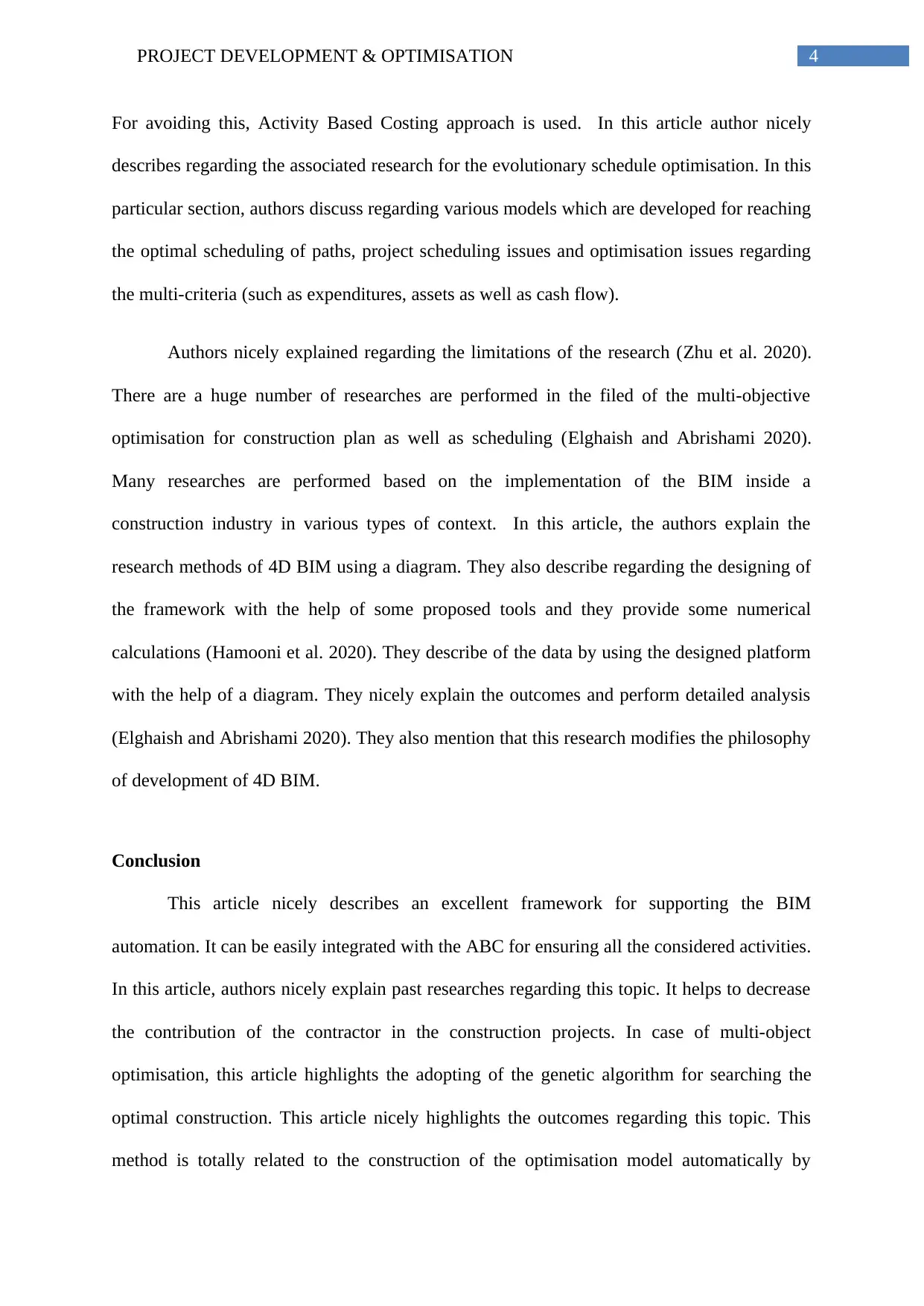
4PROJECT DEVELOPMENT & OPTIMISATION
For avoiding this, Activity Based Costing approach is used. In this article author nicely
describes regarding the associated research for the evolutionary schedule optimisation. In this
particular section, authors discuss regarding various models which are developed for reaching
the optimal scheduling of paths, project scheduling issues and optimisation issues regarding
the multi-criteria (such as expenditures, assets as well as cash flow).
Authors nicely explained regarding the limitations of the research (Zhu et al. 2020).
There are a huge number of researches are performed in the filed of the multi-objective
optimisation for construction plan as well as scheduling (Elghaish and Abrishami 2020).
Many researches are performed based on the implementation of the BIM inside a
construction industry in various types of context. In this article, the authors explain the
research methods of 4D BIM using a diagram. They also describe regarding the designing of
the framework with the help of some proposed tools and they provide some numerical
calculations (Hamooni et al. 2020). They describe of the data by using the designed platform
with the help of a diagram. They nicely explain the outcomes and perform detailed analysis
(Elghaish and Abrishami 2020). They also mention that this research modifies the philosophy
of development of 4D BIM.
Conclusion
This article nicely describes an excellent framework for supporting the BIM
automation. It can be easily integrated with the ABC for ensuring all the considered activities.
In this article, authors nicely explain past researches regarding this topic. It helps to decrease
the contribution of the contractor in the construction projects. In case of multi-object
optimisation, this article highlights the adopting of the genetic algorithm for searching the
optimal construction. This article nicely highlights the outcomes regarding this topic. This
method is totally related to the construction of the optimisation model automatically by
For avoiding this, Activity Based Costing approach is used. In this article author nicely
describes regarding the associated research for the evolutionary schedule optimisation. In this
particular section, authors discuss regarding various models which are developed for reaching
the optimal scheduling of paths, project scheduling issues and optimisation issues regarding
the multi-criteria (such as expenditures, assets as well as cash flow).
Authors nicely explained regarding the limitations of the research (Zhu et al. 2020).
There are a huge number of researches are performed in the filed of the multi-objective
optimisation for construction plan as well as scheduling (Elghaish and Abrishami 2020).
Many researches are performed based on the implementation of the BIM inside a
construction industry in various types of context. In this article, the authors explain the
research methods of 4D BIM using a diagram. They also describe regarding the designing of
the framework with the help of some proposed tools and they provide some numerical
calculations (Hamooni et al. 2020). They describe of the data by using the designed platform
with the help of a diagram. They nicely explain the outcomes and perform detailed analysis
(Elghaish and Abrishami 2020). They also mention that this research modifies the philosophy
of development of 4D BIM.
Conclusion
This article nicely describes an excellent framework for supporting the BIM
automation. It can be easily integrated with the ABC for ensuring all the considered activities.
In this article, authors nicely explain past researches regarding this topic. It helps to decrease
the contribution of the contractor in the construction projects. In case of multi-object
optimisation, this article highlights the adopting of the genetic algorithm for searching the
optimal construction. This article nicely highlights the outcomes regarding this topic. This
method is totally related to the construction of the optimisation model automatically by
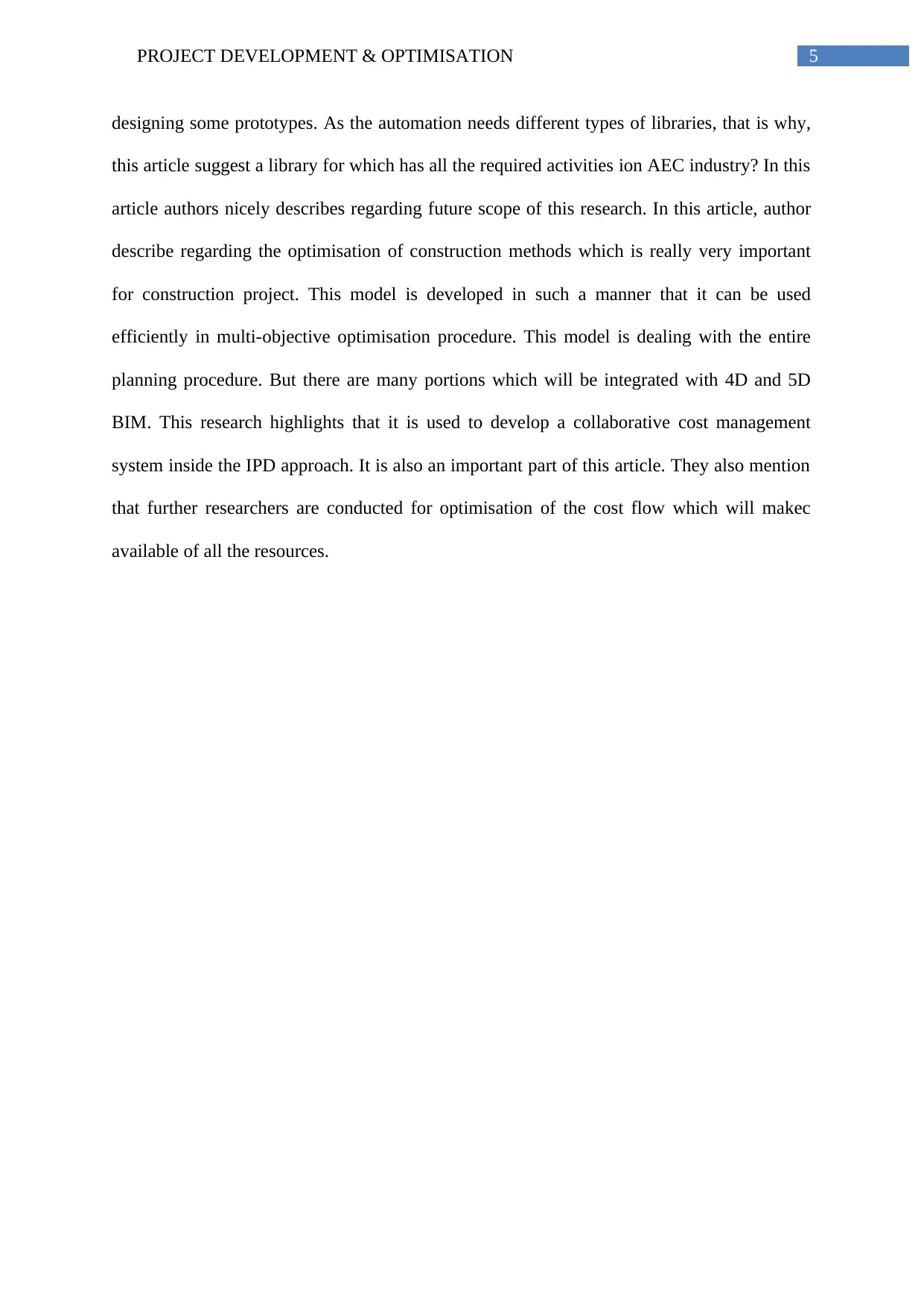
5PROJECT DEVELOPMENT & OPTIMISATION
designing some prototypes. As the automation needs different types of libraries, that is why,
this article suggest a library for which has all the required activities ion AEC industry? In this
article authors nicely describes regarding future scope of this research. In this article, author
describe regarding the optimisation of construction methods which is really very important
for construction project. This model is developed in such a manner that it can be used
efficiently in multi-objective optimisation procedure. This model is dealing with the entire
planning procedure. But there are many portions which will be integrated with 4D and 5D
BIM. This research highlights that it is used to develop a collaborative cost management
system inside the IPD approach. It is also an important part of this article. They also mention
that further researchers are conducted for optimisation of the cost flow which will makec
available of all the resources.
designing some prototypes. As the automation needs different types of libraries, that is why,
this article suggest a library for which has all the required activities ion AEC industry? In this
article authors nicely describes regarding future scope of this research. In this article, author
describe regarding the optimisation of construction methods which is really very important
for construction project. This model is developed in such a manner that it can be used
efficiently in multi-objective optimisation procedure. This model is dealing with the entire
planning procedure. But there are many portions which will be integrated with 4D and 5D
BIM. This research highlights that it is used to develop a collaborative cost management
system inside the IPD approach. It is also an important part of this article. They also mention
that further researchers are conducted for optimisation of the cost flow which will makec
available of all the resources.
⊘ This is a preview!⊘
Do you want full access?
Subscribe today to unlock all pages.

Trusted by 1+ million students worldwide
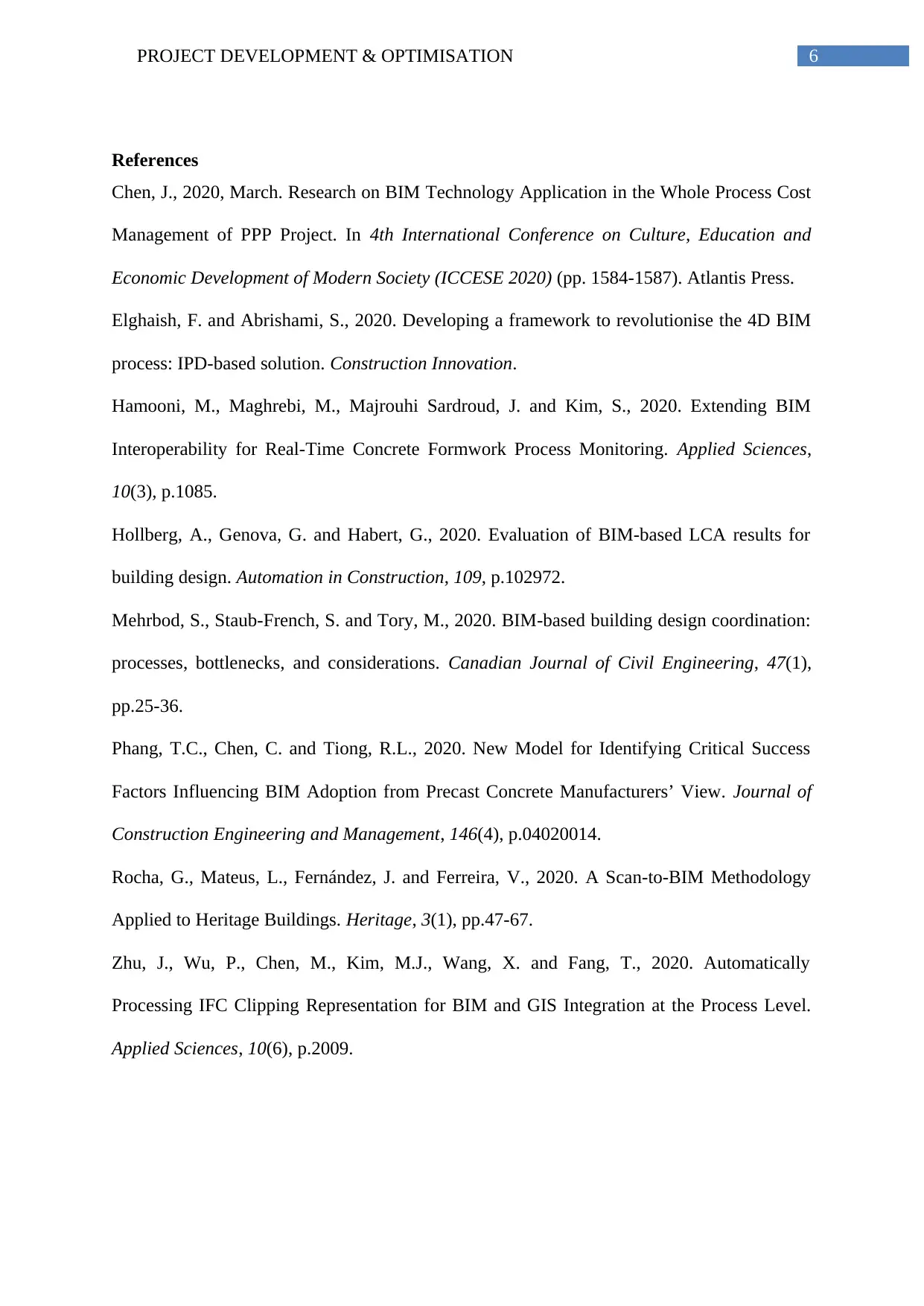
6PROJECT DEVELOPMENT & OPTIMISATION
References
Chen, J., 2020, March. Research on BIM Technology Application in the Whole Process Cost
Management of PPP Project. In 4th International Conference on Culture, Education and
Economic Development of Modern Society (ICCESE 2020) (pp. 1584-1587). Atlantis Press.
Elghaish, F. and Abrishami, S., 2020. Developing a framework to revolutionise the 4D BIM
process: IPD-based solution. Construction Innovation.
Hamooni, M., Maghrebi, M., Majrouhi Sardroud, J. and Kim, S., 2020. Extending BIM
Interoperability for Real-Time Concrete Formwork Process Monitoring. Applied Sciences,
10(3), p.1085.
Hollberg, A., Genova, G. and Habert, G., 2020. Evaluation of BIM-based LCA results for
building design. Automation in Construction, 109, p.102972.
Mehrbod, S., Staub-French, S. and Tory, M., 2020. BIM-based building design coordination:
processes, bottlenecks, and considerations. Canadian Journal of Civil Engineering, 47(1),
pp.25-36.
Phang, T.C., Chen, C. and Tiong, R.L., 2020. New Model for Identifying Critical Success
Factors Influencing BIM Adoption from Precast Concrete Manufacturers’ View. Journal of
Construction Engineering and Management, 146(4), p.04020014.
Rocha, G., Mateus, L., Fernández, J. and Ferreira, V., 2020. A Scan-to-BIM Methodology
Applied to Heritage Buildings. Heritage, 3(1), pp.47-67.
Zhu, J., Wu, P., Chen, M., Kim, M.J., Wang, X. and Fang, T., 2020. Automatically
Processing IFC Clipping Representation for BIM and GIS Integration at the Process Level.
Applied Sciences, 10(6), p.2009.
References
Chen, J., 2020, March. Research on BIM Technology Application in the Whole Process Cost
Management of PPP Project. In 4th International Conference on Culture, Education and
Economic Development of Modern Society (ICCESE 2020) (pp. 1584-1587). Atlantis Press.
Elghaish, F. and Abrishami, S., 2020. Developing a framework to revolutionise the 4D BIM
process: IPD-based solution. Construction Innovation.
Hamooni, M., Maghrebi, M., Majrouhi Sardroud, J. and Kim, S., 2020. Extending BIM
Interoperability for Real-Time Concrete Formwork Process Monitoring. Applied Sciences,
10(3), p.1085.
Hollberg, A., Genova, G. and Habert, G., 2020. Evaluation of BIM-based LCA results for
building design. Automation in Construction, 109, p.102972.
Mehrbod, S., Staub-French, S. and Tory, M., 2020. BIM-based building design coordination:
processes, bottlenecks, and considerations. Canadian Journal of Civil Engineering, 47(1),
pp.25-36.
Phang, T.C., Chen, C. and Tiong, R.L., 2020. New Model for Identifying Critical Success
Factors Influencing BIM Adoption from Precast Concrete Manufacturers’ View. Journal of
Construction Engineering and Management, 146(4), p.04020014.
Rocha, G., Mateus, L., Fernández, J. and Ferreira, V., 2020. A Scan-to-BIM Methodology
Applied to Heritage Buildings. Heritage, 3(1), pp.47-67.
Zhu, J., Wu, P., Chen, M., Kim, M.J., Wang, X. and Fang, T., 2020. Automatically
Processing IFC Clipping Representation for BIM and GIS Integration at the Process Level.
Applied Sciences, 10(6), p.2009.
Paraphrase This Document
Need a fresh take? Get an instant paraphrase of this document with our AI Paraphraser

7PROJECT DEVELOPMENT & OPTIMISATION
1 out of 8
Related Documents
Your All-in-One AI-Powered Toolkit for Academic Success.
+13062052269
info@desklib.com
Available 24*7 on WhatsApp / Email
![[object Object]](/_next/static/media/star-bottom.7253800d.svg)
Unlock your academic potential
Copyright © 2020–2025 A2Z Services. All Rights Reserved. Developed and managed by ZUCOL.





